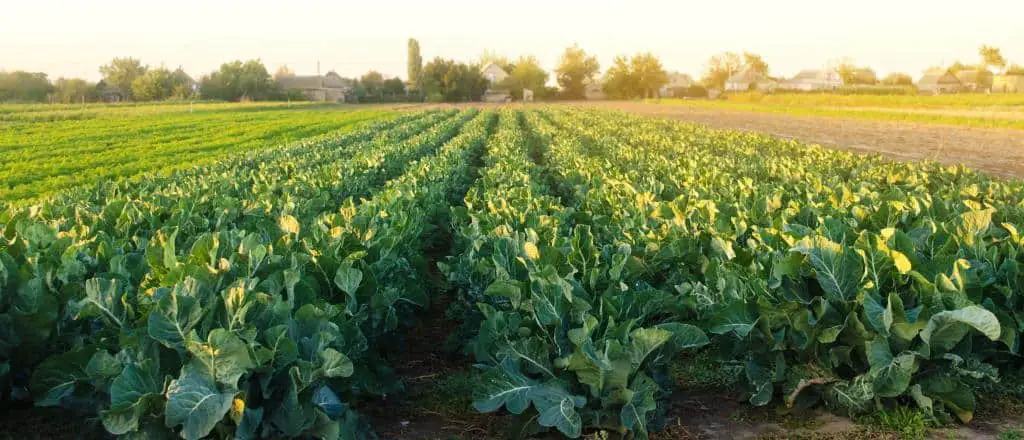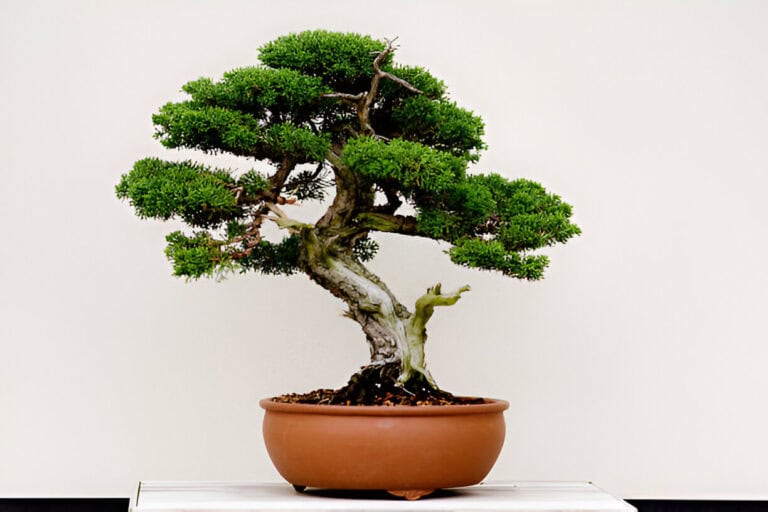How Far Apart to Plant Broccoli? Broccoli Plant Spacing Needed

Broccoli is a cool-season vegetable that is a member of the cabbage family. It is a nutritious and versatile vegetable that can be eaten raw or cooked. Broccoli is easy to grow, but it requires proper spacing to thrive.
If you’re planning to grow broccoli in your garden, one of the most important things to consider is the spacing between your plants. Broccoli plants need adequate space to grow and develop properly, and planting them too close together can lead to a host of problems, including stunted growth, disease, and a poor yield.
So, how far apart should you plant broccoli? Broccoli plants should be spaced between 18 and 24 inches apart in the garden. If you are starting with seedlings, thin them so that plants are 12 to 20 inches apart.
In this article, we’ll take a closer look at how far apart to plant broccoli and how much spacing is needed to ensure healthy, productive plants.
The Importance of Proper Spacing for Broccoli
Before we dive into the specifics of how far apart to plant broccoli, you need to understand why proper spacing is so important. When plants are placed too close together, they compete for resources like water, nutrients, and sunlight. This can lead to stunted growth, a poor yield, and an increased risk of disease and pest problems.
For broccoli plants specifically, proper spacing is critical to ensuring that each plant has enough room to develop a strong root system and absorb the nutrients it needs to grow. Broccoli plants have large root systems, and planting them too close together can lead to root crowding, which can stunt growth and reduce yield.
When broccoli plants are overcrowded, they compete for water, nutrients, and sunlight. This can result in stunted growth, poor yield, and disease susceptibility. On the other hand, if the plants are spaced too far apart, it can lead to wastage of space and resources.
Factors that Affect Spacing Requirements
The following factors can influence the spacing requirements of broccoli plants:
- Variety of Broccoli: Different varieties of broccoli have different mature sizes. For instance, some varieties can grow up to 30 inches tall, while others only grow up to 18 inches.
- Growing Conditions: The amount of space needed for broccoli plants also depends on the growing conditions. For example, if you are growing broccoli in poor soil or low light conditions, you may need to give the plants more space to compensate for the lack of nutrients or sunlight.
- Harvesting Method: The spacing requirements for broccoli plants can also be affected by the harvesting method. If you plan to harvest the broccoli heads, you may need to give the plants more space to allow for the growth of larger heads.
Read: Broccoli Seed Growth Rate: How Fast Do Broccoli Seeds Grow and Time to Harvest
How Far Apart to Plant Broccoli?
So, how far apart should you plant your broccoli plants? The answer depends on a few different factors, including the variety of broccoli you’re planting, the size of the mature plants, and your specific growing conditions.
In general, most broccoli varieties should be spaced 18-24 inches apart, with 24 inches being the ideal spacing for larger varieties. This will allow each plant to have enough space to develop a strong root system and absorb the nutrients it needs to grow, while also providing adequate space for each plant to receive plenty of sunlight.
However, if you’re growing a smaller variety of broccoli, you may be able to space your plants a bit closer together. For example, if you’re growing a mini-broccoli variety, you may be able to space your plants as close as 12-18 inches apart.
It’s also important to consider the size of your mature plants when spacing your broccoli. If you’re growing a variety of broccoli that produces larger heads, you may need to space your plants a bit further apart to allow enough room for each plant to fully mature.
Finally, take note of your specific growing conditions when spacing your broccoli. If you live in an area with hot summers, you may need to space your plants a bit further apart to prevent them from shading one another and reducing airflow, which can lead to heat stress and disease problems.
The following table provides spacing guidelines for some popular varieties of broccoli:
| Variety | Spacing Between Plants | Spacing Between Rows |
| Calabrese | 18-24 inches | 30-36 inches |
| Romanesco | 24-36 inches | 36-48 inches |
| Purple Sprouting | 18-24 inches | 30-36 inches |
How Much Spacing Area is Needed to Plant Broccoli?
Now that we’ve discussed how far apart to plant broccoli, let’s take a closer look at how much spacing is needed to ensure healthy, productive plants. As we mentioned earlier, most broccoli varieties should be spaced 18-24 inches apart, with 24 inches being the ideal spacing for larger varieties.
To determine how much space you’ll need for your broccoli plants, you’ll first need to calculate the total number of plants you plan to grow. Once you have this number, you can multiply it by the recommended spacing distance to determine the total amount of spacing area needed.
For example, if you plan to grow 10 broccoli plants and the recommended spacing distance is 24 inches, you’ll need a total of 240 inches (or 20 feet) of spacing area. This can be achieved by planting your broccoli in rows, with each row spaced 24 inches apart and each plant spaced 24 inches apart within the row.
Read: How Many Broccoli Seeds Per Hole? Perfect Planting Guide
Consider your planting area’s shape when calculating planting spacing. To calculate square footage for a square or rectangular planting area, multiply the length and width. Then, you can divide the total square footage by the recommended spacing distance to determine how many plants can fit in the space.
For example, if you have a square planting area that measures 10 feet by 10 feet and the recommended spacing distance is 24 inches, you would first calculate the total square footage of the area (100 square feet). Then, you would divide the total square footage by the spacing distance (24 inches, or 2 feet), which would give you a total of 50 plants that can fit in the space.
The above calculations assume each plant has enough space to grow a strong root system and absorb nutrients. If you plant your broccoli too close together, you may need to increase the spacing area to ensure healthy, productive plants.
Spacing Broccoli Plants in Raised Beds and Containers
When it comes to planting broccoli in raised beds, there are a few important considerations to keep in mind. Raised beds offer numerous benefits, such as improved drainage, better soil quality, and easier access for maintenance.
However, the confined space of a raised bed requires careful spacing to ensure optimal growth and yield. Guidelines for spacing in raised bed gardening can help maximize the use of available space while providing enough room for each broccoli plant to thrive.
When determining the spacing for broccoli plants in raised beds, consider the mature size of the plants. Broccoli varieties can vary in terms of their growth habits, with some producing larger heads or spreading out more compared to others. It is recommended to provide each plant with adequate space for the development of a healthy root system and proper air circulation.
Generally, a spacing of around 18 to 24 inches (45 to 60 centimeters) between plants is advisable, allowing enough room for the foliage to spread without overcrowding neighboring plants.
Spacing broccoli plants in containers presents unique challenges due to the limited space available. Container gardening offers flexibility and convenience, especially for those with limited garden space. When choosing containers for broccoli, select ones that are at least 12 to 16 inches (30 to 40 centimeters) deep to accommodate the plant’s root system.
Consider the mature size of the chosen broccoli variety to determine the appropriate container size. Additionally, proper spacing between plants is crucial in containers to prevent overcrowding, which can lead to competition for resources and hinder plant growth. Aim for a spacing of about 12 inches (30 centimeters) between plants in containers to ensure adequate airflow and nutrient availability.
Tips for Planting Broccoli with Optimal Spacing

To ensure that your broccoli plants are spaced properly, consider the following tips:
- Start with Good Soil Preparation: Ensure that the soil is well-drained, fertile, and has a pH between 6.0-7.0. This will provide the necessary nutrients for the plants to grow.
- Follow Spacing Guidelines: Plant your broccoli plants according to the spacing guidelines for your variety.
- Start with healthy seedlings: When transplanting your broccoli seedlings, make sure they are healthy and free from disease. This will help ensure that your plants get off to a good start and are able to grow and develop properly.
- Amend your soil: Broccoli plants need fertile, well-draining soil to grow properly. Before planting, amend your soil with compost or other organic matter to ensure that it’s rich in nutrients and has good drainage.
- Provide consistent moisture: Broccoli plants need consistent moisture to grow properly. Be sure to water your plants regularly, especially during dry spells, and mulch around the base of the plants to help retain moisture in the soil.
- Thin Out Seedlings: If you are growing broccoli from seeds, thin out the seedlings to ensure that each plant has enough space to grow.
- Use Companion Planting: Consider planting broccoli with other plants that can provide benefits such as pest control or nutrient fixation. Examples of companion plants for broccoli include garlic.
- Monitor for pests and disease: Broccoli plants are susceptible to a variety of pests and diseases, so it’s important to monitor your plants regularly and take action at the first sign of a problem. Use organic methods of pest and disease control whenever possible to avoid harmful chemicals.
By following these tips and spacing your broccoli plants properly, you can enjoy healthy, productive plants that provide you with delicious, nutritious broccoli all season long.
Conclusion
When it comes to growing broccoli, proper spacing is key to ensuring healthy, productive plants. By spacing your broccoli plants at the appropriate distance and providing them with the right growing conditions, you can enjoy a bountiful harvest of delicious, nutritious broccoli that will add flavor and variety to your meals.
Use the information in this article as a guide, and don’t be afraid to experiment with different spacing distances and growing conditions to find what works best for you and your garden.






